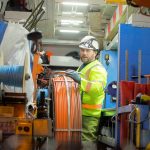Openreach Aim FTTP Broadband for 3 Million Premises in 8 UK Cities
Openreach (BT) has today announced that they intend to deploy Gigabit capable “full fibre” (FTTP) ultrafast broadband to 3 million premises in 8 major UK cities by 2020 via their new ‘Fibre First‘ build programme, which is up from the current target of 2 million by the same date.
At present the operator’s “fibre” based network covers over 27 million UK homes and businesses, although the vast majority of those are only reached via their slower ‘up to’ 80Mbps Fibre-to-the-Cabinet (FTTC / VDSL2) service. Meanwhile c.800,000 (500K on FTTP) premises can already access an “ultrafast broadband” (100Mbps+) connection via their ‘up to’ 330Mbps hybrid fibre G.fast and Gigabit capable Fibre-to-the-Premises (FTTP) technologies.
Under the previous plan Openreach had aimed to push G.fast coverage to 10 million premises by 2020 and a further 2 million would be catered for by “full fibre” FTTP within the same timeframe. On top of that the operator has also been busy consulting on an aspiration that could see them extend FTTP to as many as 10 million premises by 2025, which they said could come at a cost of between £3bn to £6bn (full details).
Advertisement
Back in October 2017 Openreach claimed to have found “broad support” for their proposal and they spoke of a desire to start the engineering work “sooner rather than later” (here), but they also warned that such a roll-out might only be possible with co-investment support from other ISPs, as well as softer regulation and reduced logistical barriers (improved planning) etc. Easier said than done.
Meanwhile Ofcom and the Government continue to pressure the operator for more action and today they reaffirmed their aspiration for 10 million FTTP premises, although for now they’ve only confirmed an accelerated rollout plan for the first 3 million. This will require them to recruit and train a further 3,000 field engineers in 2018.
The 8 Major UK Cities
Birmingham
Bristol
Cardiff
Edinburgh
Leeds
Liverpool
London
Manchester
Apparently the accelerated rollout plan for 3 million premises will eventually connect up to 40 UK towns, cities and boroughs with FTTP, with build starting in 2018 (technically the build is already underway and has been for awhile). The press release also references a desire to bring FTTP into rural areas, which is largely just a reflection of their on-going state aid backed deployments with the national Broadband Delivery UK programme.
Overall the Fibre First programme will see Openreach build FTTP to a further c.800,000 premises in BDUK areas (mostly rural) and new housing sites, and to c.1.7 million premises in towns and cities. The strategy for the next 7 million is still subject to change, depending upon whether Openreach gets the support it wants. “If Openreach is unable to secure an acceptable return, it will need to review its ongoing capital commitments to the programme,” said the operator.
Advertisement
Clive Selley, Chief Executive of Openreach, said:
“Through the Fibre First programme, Openreach is getting on with the job of building an Ultrafast Britain. We are accelerating our plans to build FTTP to three million premises by 2020 which sets the course to reach ten million by the mid-2020s with the right conditions. Where possible going forward, we will ‘fibre first’.
Working closely with Central and Local government and our Communication Provider customers, we will identify the cities, towns and rural areas where we can build a future-proofed, FTTP network that’s capable of delivering gigabit speeds to all homes and businesses at an affordable cost.
We’ll continue to invest in our people and we’re already in the process of re-training and upskilling to make Fibre First a reality. We plan to hire around 3,000 engineers in 2018/19 to kick-start Fibre First and further improve the reliability and performance of our existing networks.”
The press release doesn’t state how much investment is being committed to deliver the accelerated plan by 2020, although yesterday one contractor (MJ Quinn) seemed to be suggesting that the Liverpool deployment could suck up around £250 million (we suspect that might also include their G.fast rollout and other costs, so take with a pinch of salt).
Speaking of G.fast, Openreach clarified that their ‘Fibre First’ ethos also means they “will not build Gfast and FTTP to the same locations,” which makes economic sense in the short to medium term but we suspect that they will eventually still have to come back to those same G.fast areas and upgrade them to FTTP.
Openreach noted that the “benefits [of FTTP] include: better, more reliable service; fewer faults; and faster, more predictable and consistent speeds. The platform would be future-proof.” Meanwhile the operator also took the opportunity to identify a set of enablers that will be needed if they are to underpin a “viable commercial business case” for deploying FTTP to 10 million premises in the future.
Enablers
1. Build and connection costs
The cost of building FTTP varies significantly depending on the exact location. Openreach expects the cost of building FTTP in towns and cities over the next three years to be around £300-£400 per premise passed. If the costs of battery back-up are excluded for the majority of customers, we expect connection costs to be around £150-£175.
ISPreview’s Note: As an example, current connection charges for ultrafast FTTP 160Mbps range from £92 to £117 +vat. Openreach’s current ultrafast FTTP pricing ranges from £19.78 to £21.39 for 160Mbps with connection fees for £92. This of course excludes all of the extra costs that ISPs then have to add on top (capacity, network, profit margins, 20% VAT etc.).
2. Take-up and Revenue
The consultation identified three sources of value: lower Openreach operating costs enabled by the new platform; incremental revenue per line from Openreach’s wholesale charges to CPs; and the benefit to Openreach from a more competitive network. Our further analysis continues to indicate that all three sources of value will be needed to secure acceptable returns.
To maximise the potential of a large-scale new FTTP deployment, Openreach believes it is essential to move all customers onto the new network quickly once built. In the first instance Openreach believes mass market adoption at competitive prices [see directly above] can be pursued through commercial agreements with CPs, and will explore models to achieve this in parallel with accelerating its FTTP build. Ultimately a ‘switchover’ process will be required, moving all customers onto the FTTP network so that everyone benefits. Openreach will consult with CPs and other stakeholders on how this can be achieved in due course.
3. A supportive regulatory and public policy framework
To maintain momentum on building more FTTP into the 2020s, a supportive regulatory and public policy framework is essential. Openreach is encouraged by its initial engagement with both Ofcom and Government, and looks forward to continuing to work with both to secure the right conditions for sustained commercial investment. Key requirements include:
i. the extension of Cumulo rates** relief to better reflect the long-term nature of FTTP infrastructure investment timescales;
ii. certainty around the fair bet framework to ensure that initial and subsequent rounds of investment have the opportunity to earn returns that fully reflect the risk taken at the time of investment, and where competition is effective, greater commercial freedom;
iii. support for and help with a switchover process when this ultimately becomes required to maximise the benefits of the platform;
iv. close partnerships with local authorities to reduce red tape and provide a smooth path to delivery. Openreach has already piloted a co-located Fibre First team with the City of London Corporation and will now replicate this model with other local authorities as part of the Fibre First project.
** “Cumulo rates‟ is the phrase used to describe a tax on commercial property. The “commercial property” taxed in this way is defined by the Valuation Office Agency (“VOA”) as BT‟s network (ducts, poles, parts of exchange buildings and other assets).
Meanwhile Openreach’s rivals (e.g. Vodafone, Cityfibre, Hyperoptic, Gigaclear etc.) seem to be growing their deployment strategies and investment pots and often without requiring some of the above changes, although they aren’t held to the same stiff and complicated regulation as Openreach.
Advertisement
UPDATE 9:48am
A Statement from Cityfibre has been issue.
Cityfibre Statement
As a business founded to deliver a new digital infrastructure platform for the UK, we welcome any contribution, from any source, that supports a drive towards national coverage. Today’s announcement from Openreach is a clear response to competition from CityFibre and other alternative full fibre infrastructure builders.
It is clear that it’s in UK consumers’ and businesses’ best interests to deliver full fibre connectivity to the maximum possible number of premises in the shortest possible time and at the best possible value.
CityFibre and Vodafone is already leading the way, with a long-term strategic partnership that will bring ultrafast Gigabit-capable full fibre broadband to up to five million UK homes and businesses, approximately 20% of the UK market, by 2025.
It is recognised by government and Ofcom that the time has come to reduce the public’s dependency on Openreach. It is not in the UK’s best interest to encourage further entrenchment of the incumbent monopoly. As successfully demonstrated all over the world, it is a new generation of infrastructure builders that are best placed to deliver full fibre – able to deliver the next generation of digital connectivity faster and at lower prices than incumbent operators.
UPDATE 11:07am
Now a comment from Hyperoptic’s boss.
Dana Tobak CBE, CEO and MD of Hyperoptic, said:
“Hyperoptic welcomes naysayers Openreach to the Full Fibre table but find their motives and focus suspect. For years, Hyperoptic have been leading the Full Fibre transformation, ensuring that our cities are ready for their digital futures, while Openreach has focused on fibre to the cabinets and convincing the country that we’d never need more than 30 mbps.
During that same period, Hyperoptic has rolled out Full Fibre to 30 cities and enabled a digital transformation within those catchment areas. Indeed, 1 in 7 central London and Manchester residents have access to Full Fibre, and across the Openreach’s future phase 1 territories Hyperoptic already cover 10% of properties with plans already in progress for our greater vision. We re-iterate and confirm our target for 2m homes passed for 2020 and 5m for 2025.
We also call on Ofcom to ensure that the Fibre First announcement is not a distraction from fulfilling the strategy of 2016’s Digital Communications Review, which rightly concluded that the UK is best served with Infrastructure competition. Openreach must be regulated to use its own duct and pole product when implementing its FTTP roll out so there is equivalent opportunity to build FTTP networks at scale and that Fibre First isn’t just a marketing name for Openreach’s Fibre Monopoly.
Hyperoptic has demonstrated its ability and commitment to transforming broadband into future proofed digital connectivity. Our customers enjoy 1 Gb connectivity for 20% less than BT’s 300 Mb product and with a customer satisfaction score of over 92% its proof that a competitive infrastructure environment is good for consumers.
Lets get away from accepting short term solutions at the expense of the digital future of the UK.”
UPDATE 12:52pm
The Government has sent along their reaction.
Matt Hancock, DCMS Secretary of State, said:
“Full fibre connectivity will be vital in building a Britain that’s fit for the future and can attract investment in a global market. I’m glad that Openreach have begun to make this shift in strategy, away from reliance on copper based systems and in favour of the best modern technology.
We want to encourage a competitive market to rollout this technology and we will work with Openreach, Virgin, CityFibre, Gigaclear, TalkTalk and the growing number of full fibre broadband providers to build a Britain fit for the future.”
Mark is a professional technology writer, IT consultant and computer engineer from Dorset (England), he also founded ISPreview in 1999 and enjoys analysing the latest telecoms and broadband developments. Find me on X (Twitter), Mastodon, Facebook, BlueSky, Threads.net and Linkedin.
« A Third of UK Businesses to Invest in Ethernet and Broadband in 2018















































Comments are closed